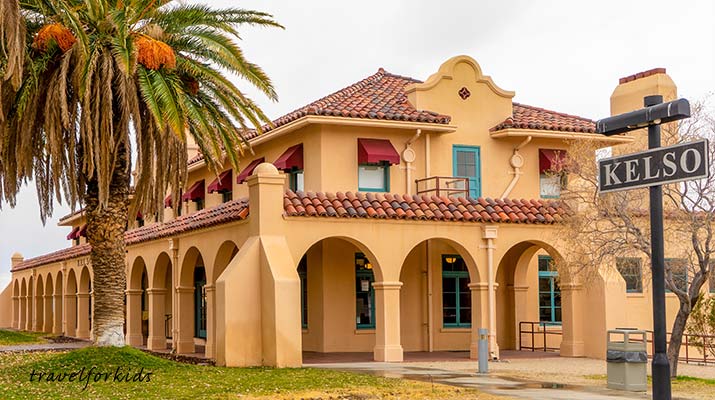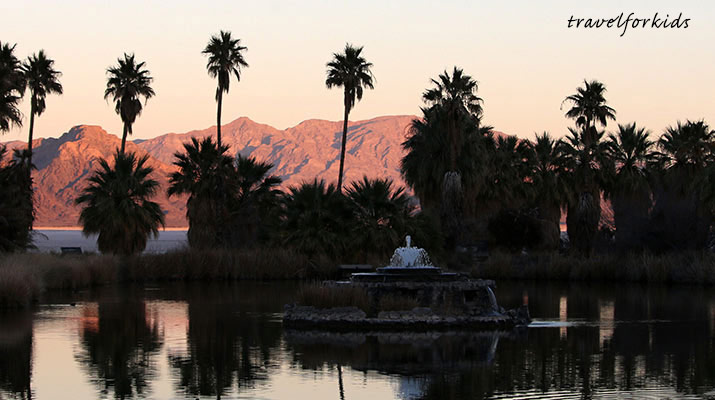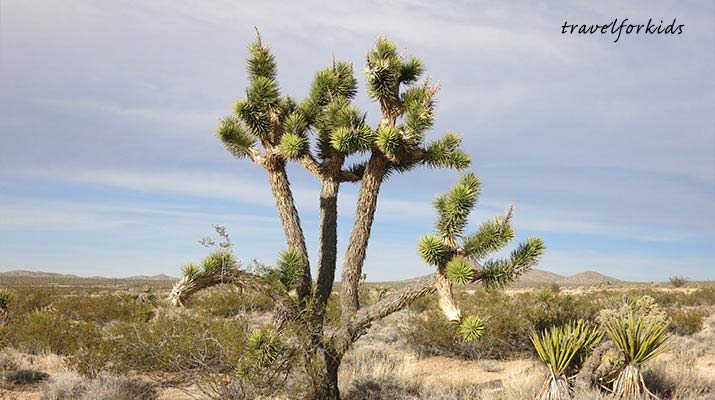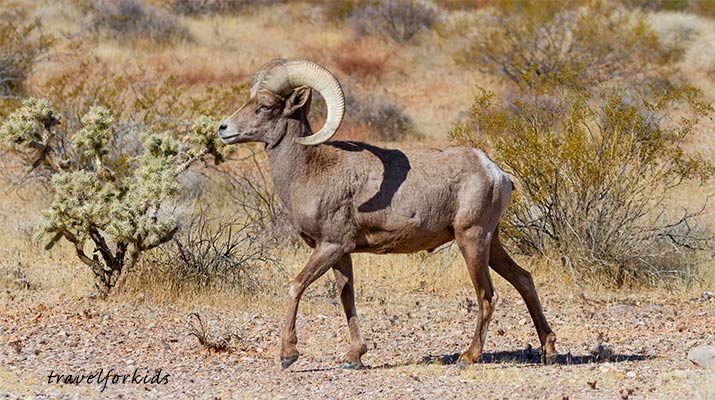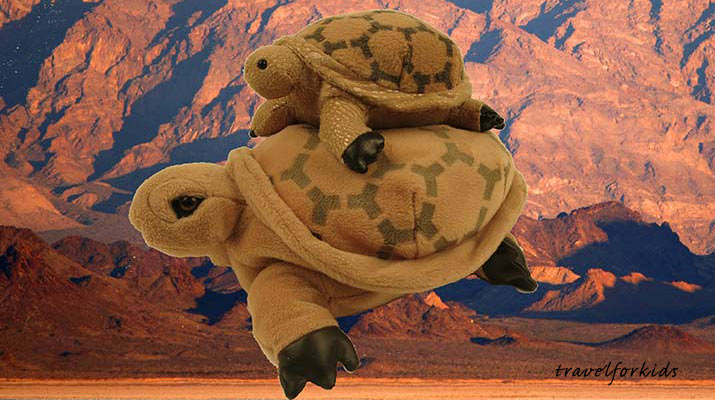On Presidents Day weekend, we took a trip to Mojave National Preserve. Not as well known as Death Valley National Park to the north, or Joshua Tree National Park to the south, the preserve has the best sand dunes for kids, and Kelso Dunes are bigger than the dunes in Death Valley.
Kelso Dunes
We got an early start to hike up Kelso Dunes. Even in spring, temperatures are very comfortable in the morning, but by noon, it’s much hotter.
From the parking lot, there are two trails (footprints in the sand) leading up to the tallest sand dune. Kids of all ages will have fun playing and hiking these dunes.
With toddlers and younger kids, just walk into the sandy hills as far as you like, then play in the soft, fine-grained sand – it’s one big sandbox.
For older kids, hike up to the summit of the tallest dune, like intrepid explorers. The panorama of the surrounding desert and mountains is superb. No need to follow the trail you came up, it’s easy to run down the dune. Coming down the slope, listen for the sounds of the “singing sands,” a low pitched ka-boom, ka-boom sound as your feet dislodge the sand. (Tip: Shoes will get filled up with sand, so wear lightweight shoes, to easily take off and pour out the sand.)
As you walk up to the dunes, look for tracks in the sand. During the night, large and small animals are active, and you can see patterns left by their nighttime treks. Around plants are circles in the sand, blown by the wind.
The dunes teem with animal and plant life. In spring, pink, yellow and white wildflowers bloom in the sands. We saw lizards, black darkling beetle, kangaroo rat tracks and burrows, and tracks of birds.
Tip: Going out to the dunes, be sure to have water with you, and snacks if you’re hiking to the top.
Kelso Depot Visitor Center
The visitor center is situated in the old Kelso railroad depot. In the early 20th century, Union Pacific constructed a railroad from Los Angeles to Salt Lake City through the inaccessible Mojave Desert, and built a stop here in Kelso. During World War II, the depot shipped iron ore from a nearby mine, and was a transport hub for troops. The depot has been preserved, and freight trains still go through, but don’t stop.
At the visitor center pick up the park brochure with maps, and check out exhibits of wildlife and plants of the preserve – the endangered desert tortoise, creatures that leave their tracks in the sand such as lizards, tiny kangaroo rats, beetles, snakes, flowers that bloom in spring, white desert primrose, pink sand verbena, yellow desert marigolds. Also, listen to sounds of the “singing sands.”
There are restrooms inside the visitor center, and picnic tables out front. Also, it’s fun to watch the long-distance freight trains going by, some are over a hundred cars long. Kids will enjoy the experience of watching the end of the train disappearing into the infinite distance of the desert.
Zzyzx – Soda Springs
At the end of the day, before sunset we drove over on Zzyzx. Here fresh water springs bubble up into a large pond, surrounded by palm trees. The palms aren’t native, they were planted in the mid 20th century, when Zzyzx was a health resort. We watched ducks paddling peacefully around the pond, and looked out over the white playa. Here the Mojave River evaporates into the sand, leaving dry Soda Lake. The sand from the playa blows east, and forms the Kelso Dunes.
The Mojave desert is remarkable for kids, from endless blue skies to tiny tracks in the sand, a landscape shaped by wind, searing heat and freezing cold, an environment that is both timeless and living.
Plants and wildlife
Mojave National Preserve has a variety of habitats, from desert dunes, to Joshua tree forests and pinyon-juniper woodlands. Plants and animals are beautifully adapted to thrive in this extreme landscape. Many animals only come out at night (look for their tracks), or early morning when it’s cooler.
Throughout the preserve, you’ll see the spiky Joshua trees (not really “trees” per se, they are flowering yuccas.). Joshua trees have evolved to survive in the desert, and provide food and shelter for birds and animals. The spiky leaves catch every bit of moisture, which is stored in the tree trunk. Birds nest in the tree, squirrels eat the flowers and fruit, kangaroo rats use it for shelter, dead trees are food for termites and stinkbugs.
Drive along Cima Road, stopping at Teutonia Peak Trail, to see the biggest Joshua tree forest in the preserve.
Desert tortoises live up to fifty, perhaps hundred years. They eat wildflowers, flowers and leaves, and some grasses and cactus fruits. Desert tortoises have good eyesight and sense of smell, a tough shell, and short scaly legs. In winter months they hibernate in burrows. The desert tortoise is endangered, and if you see one, do not try to touch them (desert tortoises can get diseases from humans).
Look for different kinds of cactus, which bloom in spring. We saw cholla, barrel and pancake pear cactus, photo above.
Lizards are “sand swimmers” – they can run across the sand, over 10ft per second (after hiking through the soft sand in the dunes, imagine running that fast with with human feet). Look for fringe-toed lizards in the Kelso Dunes.
Bighorn sheep are native to the Mojave desert, their hooves adapted to the rocky terrain. They live in mountainous areas, but come down to drink at springs and water holes. We didn’t see any bighorn sheep during our visit, and sightings in the wild are rare, but they are majestic animals. (Tip: At San Diego Safari Zoo Park check out the desert bighorn sheep enclosure.)
Tips for Mojave National Preserve
- Take lots of water with you, even on a short walk!
- Wear sunscreen and hats.
- Have a full tank of gas – there are no gas stations inside the preserve.
- Bring a cooler in the car for cold drinks, and have snacks and picnic supplies.
- DO NOT VISIT IN SUMMER, temperatures are above 100 degrees.
- Mojave National Preserve covers a large area (similar to Yellowstone), with few towns close by. For the best desert experience, go camping in the preserve.
Find out more about fabulous California Deserts on Travel for Kids – Death Valley National Park, Joshua Tree National Park, Palm Springs, and Anza Borrego
Who’s this? Meet “Shelley” and “Shellette” desert tortoises.


